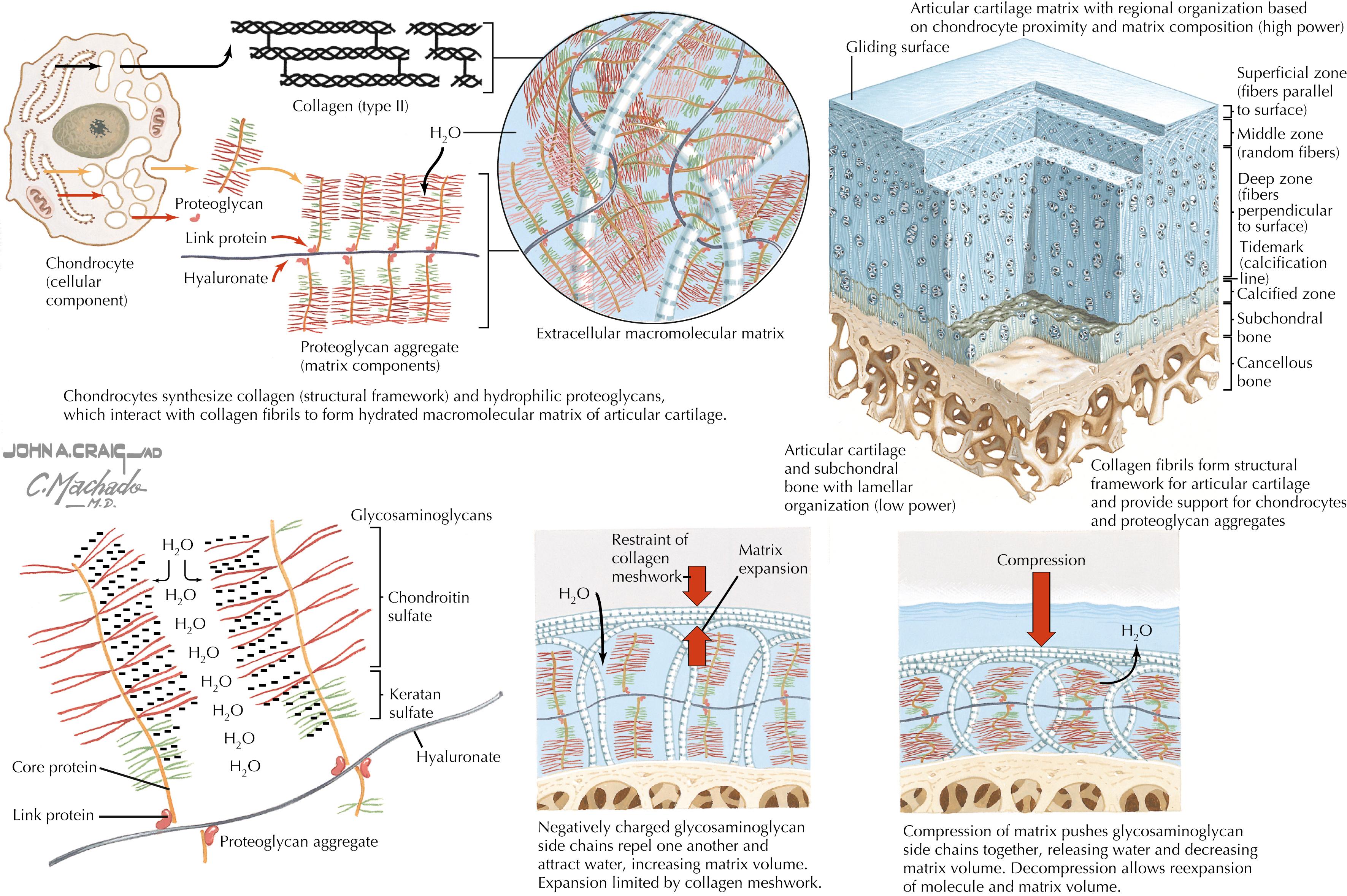Physical Address
304 North Cardinal St.
Dorchester Center, MA 02124
Functions to decrease joint friction and distribute load across the joint; also referred to as articular cartilage
Composition: Water (65%–80%), collagen (10%–20%, predominantly type II), proteoglycans (10%–15%, aggrecan is most responsible for the hydrophilic property), and chondrocytes (5%) ( Fig. 57.1 )

Viability: Articular cartilage is avascular, and chondrocytes are nourished via diffusion from synovial fluid
Structure: Organized into three primary layers—superficial, middle, and deep; the tidemark separates these layers from the calcified cartilage and subchondral bone (see Fig. 57.1 )
Location: Articular surfaces, ribs, and nasal septum
Functions in direct tendon and ligament insertions and helps in the healing of articular cartilage lesions. Less durable than hyaline cartilage.
Composition: Primarily type I collagen, extracellular matrix, chondrocytes, water
Location: Tendon/ligament junction with bone, menisci, and annulus fibrosis of the intervertebral disc
Strong but flexible cartilage that can withstand repeated bending
Composition: Primarily type II collagen, elastin fiber network, extracellular matrix, chondrocytes, water
Locations: Pinnae of ear, epiglottis
Can be caused by either acute injury or a more chronic, avascular process
Deep lesions: Cross the tidemark and penetrate the subchondral bone; vascularity from the subchondral bone promotes fibrocartilage healing (type I collagen) rather than the preferred articular cartilage
Superficial lesions: Do not penetrate the subchondral bone and therefore have no intrinsic healing potential secondary to the avascular nature of articular cartilage
Healing is enhanced by motion of the involved joint to encourage diffusion of nutrients and to trigger mechanoreceptors in the cartilage that promote matrix synthesis
An apophysis is a normal developmental outgrowth of cartilage adjacent to the physis that serves as the attachment site for major tendons and ligaments
Is a separate secondary ossification center from the epiphysis and does not contribute to longitudinal growth of the bone
Fuses with the bone later as skeletal maturity is reached
Traction apophysitis: Repetitive microtrauma caused by the pull of attached tendons; results in partial avulsion and inflammation of the apophysis; common in active children and adolescents; excessive force may result in avulsion fracture of the apophysis
Osteochondrosis: General term for disorders affecting one or more ossification centers in children; encompasses conditions such as traction apophysitis and avascular necrosis
A detailed description of the onset of symptoms, mechanism of injury, duration and quality of symptoms, and any relieving or exacerbating factors should be obtained
Symptoms may include pain with activity, swelling of the affected joint, and mechanical complaints, such as clicking and locking
Overuse injuries typically have an insidious onset with no identifiable precipitating injury
Few, if any, physical examination tests are highly specific for the evaluation of articular cartilage injury
A complete examination of the involved joint should be conducted, including range of motion, assessment of pain with resisted motion, focal tenderness, and presence of an effusion
Apophyseal injuries can present with pain upon palpation of the affected apophysis and pain with resisted motion of the muscle or ligament that attaches at the apophysis
Become a Clinical Tree membership for Full access and enjoy Unlimited articles
If you are a member. Log in here